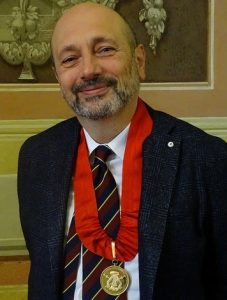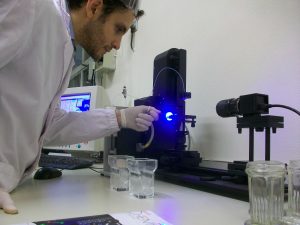Piersandro Pallavicini
[CHIM/03 Chimica Generale e Inorganica- sett.concorsuale 03/B1)]
photocredits: Pierino Sacchi 2017
CV
Piersandro Pallavicini was born in Vigevano, Italy, on 4th September 1962.
Studies
- P. Pallavicini took the “Laurea” degree in Chemistry in November 1986 from the Università di Pavia (110/110 cum Laude)
- In 1990 he got the PhD in Chemistry from the Scuola Normale Superiore di Pisa the “Diploma di Perfezionamento In Chimica”, discussing a thesis with the title «Synthesis and reactivity of group 4 organometallic compounds» with prof. Fausto Calderazzo, prof. Gerhard Erker (Universität Münster, Germany) and prof. Lido Porri (Politecnico di Milano) as supervisors (70/70 cum laude).
Professional positions
- He then went back to the University of Pavia, at the Dipartimento di Chimica Generale, where from 1990 to november 1994 he worked as assistant technician.
- In december 1994 he obtained the permanent position of researcher (“Ricercatore”).
- In 2010 he became Associate Professor (Professore Associato) at the Department of Chemistry (Dipartimento di Chimica) of the University of Pavia.
- In 2017 he became Full Professor (Professore Ordinario) at the Department of Chemistry (Dipartimento di Chimica) of the University of Pavia.
Research
- In Pavia he first worked first in the group of Professor Luigi Fabbrizzi (coordination, macrocyclic and supramolecular chemistry)
- since 2000 he developed his own research, soon forming his research group and starting national and international collaborations.
- His early research in Pavia regarded poliamino macrocycle coordination chemistry, multicenter redox systems based on transition metals, template syntheses of macrocyclic complexes featuring additional functional groups, molecular switches, fluorescent sensors for transition metals, anion receptors based on transition metals. PP developed a special interest and expertise in the electrochemical characterization of the prepared systems, and in the determination of the protonation and complexation constants of ligands and receptors.
- successive research areas were:
i) systems capable of pH- and electrochemically controlled translocation of anions and cations at the molecular level (including the possibility of movement signallation by means of fluorescence)
ii) the controlled electrochemical self-assembly/disassembly of supramolecolar helicates, that display an hysteretic behaviour and whose state can be signalled by fluorescence
iii) the self-assembly of transition metal helicates with self-recognizing ligands and enhanced enantioselectivity
iv) fluorescent sensors and selective receptors for cations, anions and pH based on supramolecular micellar systems
v) molecular machines that behave as activable selective receptors for molecular substrates
vi) the preparation and study of Si surfaces on which are grafted electroactive transition metal complexes, receptors for transition metals and systems capable of controlled cation translocation. - Beginning with 2005, his interests shifted to the application of inorganic chemistry and coordination chemistry to the nanoscale, including surface modification, inorganic nanoparticles, and nano-sized containers for self-assembled supramolecular systems. Briefly, PP works in these areas:
i) modification of inorganic surfaces with covalently grafted metal complexes and ligands, with particular attention to their antibacterial applications.
ii) synthesis of silver and gold nanoparticles, and their functional coating. Detailed studies were dedicated to biocompatible coatings of silver NP, to their use as microbicidal materials, to the synthesis of shape- and dimension-controlled non-spherical Au NP, and to the use of the latter for drug loading and delivering
iii) formation of monolayers of Ag or Au NP on bulk inorganic surfaces, with detailed studies of their antibacterial applications.
iv) photothermal and luminescent properties of Au and Ag non-spherical NP and of their monolayers on bulk materials
v) sensors based on the optical properties of non-spherical Au NP
vi) micelles as containers for self-assembled sensors for metal cations, pH-windows and lipophilicity
Lectures
Recently financed projects
- In the period 2007-2010 PP was the principal investigator in the research project financed by Fondazione Cariplo: “Glass surfaces with antimicrobial action based on the tunabled release of metal cation: a wide-spectrum study on the use of surface coordination chemistry and monolayers of modified nanoparticles to prepare smart materials of biomedical interest”[project #2007-5183])
- In the period 2011-2014 Fondazione Cariplo financed the research “Gold nanorods (NR) and asymmetic nanoparticles coated with biocompatible polymers with binding functions for molecules and metal cations: antimicrobial action of pharmacological and thermal nature, activated by NearIR irradiation”[project #2010-0454]
- In the year 2007 PP has also been financed by “Università Italo-Francese” for a “Galileo” project, in collaboration with LIMSAG de l’Universitè de Bourgogne (Francia) for the project “Segnalazione tramite fluorescenza ed estrazione di cationi metallici da parte di leganti macrociclici incorporati in micelle”
- In the period 2012-2016 he has been local coordinator for the Pavia unit ot the PRIN 2010-11 project “Indentification of optimal release systems for Nucleic Acid Based Drugs and study of the action mechanisms in some models of inflammatory and tumoral human pathologies” (project 20109PLMH2_003)
- for the period 2017-2019 he is the Principal Investigator of a ‘Blue Sky’ research project “Photothermally responsive inks for inkjet‐printing secure informations” financed by University of Pavia
Honours
- In 2001 he received from the “Divisione di Chimica Inorganica della Società Chimica Italiana” the
“Raffaello Nasini” gold medal, a prize reserved to under 40 researchers, that was given to him with the motivation: “per i notevoli risultati ottenuti nell’ambito della chimica supramolecolare inorganica che hanno portato ad importanti contributi innovativi sia al disegno di dispositivi molecolari e sensori che alla tematica del movimento orientato di molecole” - In the year 2005 he has been “Professeur Invitè” at the Laboratoire de Chimie Organo-Minérale, Faculté de Chimie, Institut Le Bel, Université Louis Pasteur in Strasbourg, France, hosted by the group of Prof. Jean-Pierre Sauvage.
- In the years 2007 and 2009 he has been “Professeur Invitè” at the Insitut de Chimie Moleculaire de l’Universitè de Bourgogne, Dijon, France, hosted by the group of Prof. Franck Denat.
Active research collaborations
- Università Milano Bicocca; Università di Palermo; Seconda Università di Napoli)
- University of Liverpool, UK; Université de Bourgogne, France; KAUST, Saudi Arabia; Turku University, Finland)
Teaching
- From 1997 PP teached courses for the laurea degree in Farmacia (Pharmaceutical Sciences), for the Laurea Triennale in Chimica (Chemistry) and for the Laurea Magistrale in Chimica.
Presently (2017) he holds the courses of Chimica Generale e Inorganica (Pharmaceutical Sciences, 7 credit units); Chimica Generale e Inorganica (for Chemistry, Laurea Triennale, 9 credit units); Inorganic Nanochemsitry (for Chemistry, Laurea Magistrale, 6 credit units)

